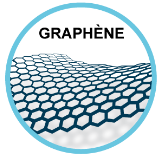 Graphene, a recently discovered alternate form of carbon is slowly coming out of the university laboratories into commercial use. It is nearly impossible to overstate the many possible uses for this new material, 200 x stronger than steel.
Graphene, a recently discovered alternate form of carbon is slowly coming out of the university laboratories into commercial use. It is nearly impossible to overstate the many possible uses for this new material, 200 x stronger than steel.
When mixed into concrete, or rubbers it bonds and makes them far stronger. It is the best conductor of electricity and heat in the world.
Graphene is light weight and almost transparent. Graphene can exist as tiny thin flakes so small they can be invisible to the human eye, small enough to inhale, and may have sharp edges.
The Good News: Researchers at Rice University recently discovered that passing a momentary intense pulse of electric current through a short length of carbon-bearing material (like coal, or even coffee-grounds) converted most of it into layers of high-purity Graphene! The US government has contracted with those researchers to develop a larger-scale production process to make Graphene material.
Other labs around the world have developed other but slower ways to produce graphene.
The Bad News: Workers around sites producing Graphene must be careful not to ingest or inhale any of the tiny flakes of that material. It may be harmful, but little is published on that subject! Well Guess What: Old Mother Nature may have been producing aGraphene-like product forever but did not tell us!
Fact: Lightning strikes over our entire Earth happen about 100 times per second!
Lightning is a momentary intense pulse of electric current between acloud and the earth’s carbon-rich surface. What if the lightning strikes in a bed of coal or any carbonaceous material?
Do we get instant Graphene blowing in the wind? If so, where has it been all these centuries? On our food? Inside our bodies? Is that what killed off the Neanderthals?
We should not ignore the possible dangers from this amazing new material, Graphene.
Frank W Motley 5/1/20 Glendale, CA.
